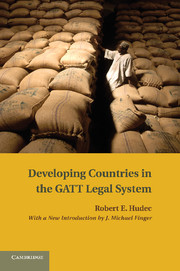Book contents
- Frontmatter
- Contents
- Foreword by Hugh Corbet
- Acknowledgments
- DEVELOPING COUNTRIES IN THE GATT LEGAL SYSTEM
- Introduction to the New Edition
- PART I A HISTORY OF THE LEGAL RELATIONSHIP
- 1 Post-war Negotiations on Trade Liberalization
- 2 First Decade of the GATT – 1948–1957
- 3 Demands for a New Legal Relationship – 1958–1963
- 4 Defining the New Relationship – 1964–1971
- 5 Testing the New Relationship – 1972–1979
- 6 Developments in the 1980s – Form without Substance
- PART II A LEGAL CRITIQUE OF THE GATT'S CURRENT POLICY
- List of References
- Index
2 - First Decade of the GATT – 1948–1957
Published online by Cambridge University Press: 03 May 2011
- Frontmatter
- Contents
- Foreword by Hugh Corbet
- Acknowledgments
- DEVELOPING COUNTRIES IN THE GATT LEGAL SYSTEM
- Introduction to the New Edition
- PART I A HISTORY OF THE LEGAL RELATIONSHIP
- 1 Post-war Negotiations on Trade Liberalization
- 2 First Decade of the GATT – 1948–1957
- 3 Demands for a New Legal Relationship – 1958–1963
- 4 Defining the New Relationship – 1964–1971
- 5 Testing the New Relationship – 1972–1979
- 6 Developments in the 1980s – Form without Substance
- PART II A LEGAL CRITIQUE OF THE GATT'S CURRENT POLICY
- List of References
- Index
Summary
OF THE ORIGINAL twenty-three contracting parties of the GATT, ten were developing countries: Brazil, Burma, China, Ceylon, Chile, Cuba, India, Pakistan, Syria and Lebanon. Within the first few years China (by then the Taiwan government), Lebanon and Syria withdrew. Four more developing countries acceded in the Annecy negotiations in 1949: the Dominican Republic, Haiti, Nicaragua and Uruguay. Indonesia became a contracting party in 1950 on achieving independence; Peru and Turkey negotiated their entry during the Torquay Round negotiations of 1951. By the end of the Torquay Round negotiations, the total developing-country membership stood at fourteen. The developed-country membership had risen to twenty and included all the major developed countries except Japan, which joined in 1955, and Switzerland, which joined in 1966.
EVOLUTION OF DEVELOPING-COUNTRY MEMBERSHIP
Developing-country membership remained virtually unchanged during the rest of the 1950s. Only Ghana and Malaysia acceded, both entering in 1957 under special procedures that allowed newly independent territories to succeed to the rights and obligations of their parent countries. In the late 1950s, the situation began to change when a number of newly independent developing countries began to establish provisional contacts with the GATT. By the end of the decade, however, the total membership of the GATT stood at only thirty-seven, and developed countries still held a twenty-one to sixteen majority.
- Type
- Chapter
- Information
- Developing Countries in the GATT Legal System , pp. 39 - 50Publisher: Cambridge University PressPrint publication year: 2010



